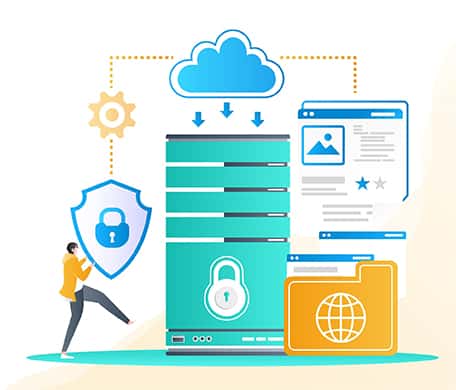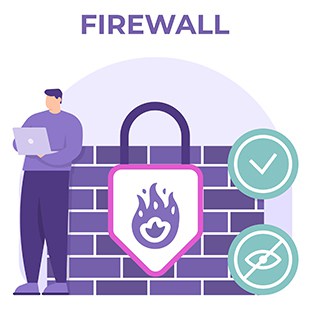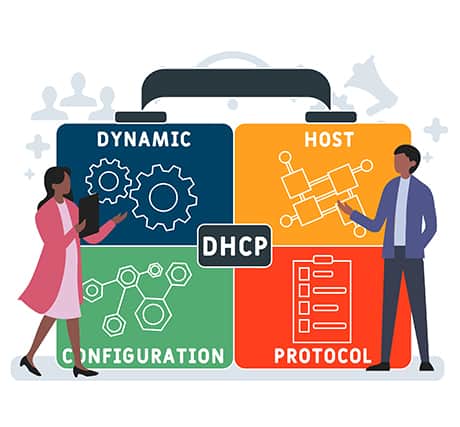
A firewall is a category of EDR tools (Endpoint Detection and Response tools). EDR solutions are in charge of monitoring a network’s entry points and endpoints. EDR tools vary in the depth of data protection coverage, similar to firewalls. Some can recognize only the most blatant network and malware threats. Others use innovative features to increase the firewall’s security level, including behavioral analysis, machine learning and artificial intelligence. Firewalls are employed in commercial and residential settings. Modern enterprises integrate firewalls into a security information and event management (SIEM) strategy with other advanced cybersecurity tools. Firewalls maintain a record of occurrences that administrators can use to spot trends and enhance rule sets. Rules should be changed frequently to stay up with the constantly changing cybersecurity risks. Vendors release updates to address these threats as soon as new dangers are identified.
Table of Contents
What Is a Firewall?
A firewall is a cybersecurity program that filters data trying to access networks or computers. The firewall blocks any data packets classified as security risks from getting into the network or devices. Data packets are units of data structured for internet transfer. Firewalls check if certain data packets comply with established rules. If the packets don’t comply, the firewall will stop the packets from entering the guarded network.
Firewalls exist in two categories, software and hardware firewalls. Software firewalls are programs installed on computers that regulate data flow through applications and ports to monitor and manage users, generate logs and block applications. A hardware firewall is a tool between the gateway and the network. Routers are examples of hardware firewalls, although there are more specialized devices for larger-scale uses.
How Does a Firewall Work?
Firewalls inspect incoming traffic under pre-established protocols and block traffic from untrusted or unverified sources to prevent network attacks. Firewalls control traffic at entry points or computer ports, transferring data to and from exterior devices. A firewall will only accept inbound connections that the firewall has been set up to accept. Firewalls achieve this by accepting or blocking particular data packets (the units of communication the user transmits over digital networks) per previously established security protocols. Only reliable IP names or sources are permitted.
The purpose of firewalls is to protect private networks and the network hosts (endpoint devices) that reside within the network. Devices that interact with other servers on a network are called network hosts. Network hosts communicate with internal networks and incoming and outgoing traffic between external networks. Networks enable computers and other peripheral devices to connect to the internet and one another.
What Are the Advantages of a Firewall?
One disadvantage of firewalls is one of the major responsibilities of firewalls, monitoring traffic. The firewall inspects all packets for any harmful threats and blocks these threats. Another advantage is offering protection against Trojans secretly spying on the user’s online activities. A firewall is also beneficial in preventing system hacking, accessing control, improving online privacy, easy installation and offering virtual connectivity services.
What Are the Disadvantages of a Firewall?
Acquiring a firewall, especially hardware firewalls, costs an organization a lot of money. Firewalls come with installation and maintenance charges. The cost depends on the type of firewall chosen. Another disadvantage is performance-related. Firewalls can restrict a computer system’s performance. This network security solution uses Random Access Memory (RAM) and other system resources which stop the system from functioning to the system’s full potential, affecting speed.

Firewalls can also cause malware attacks. Although firewalls can block most trojans, some advanced malware bypass firewall protection. Some malware can enter the system as approved data. Also, large organizations need dedicated staff to manage firewalls. These individuals guarantee the barrier is secure enough to keep outsiders out of the network.
A firewall can also lead to internal network attacks. Identifying attacks can be challenging when attackers access the internal network system. Because of this, the firewalls cannot identify sources with valid entry credentials for the system. The firewalls are created and developed to prevent external attacks from other sources, so firewalls cannot handle such events that occur inside the networks.
What Are the Different Types of Firewalls?
Firewalls are categorized based on the operation mode. The type of firewall can be software or hardware. A software firewall is placed on individual devices, providing precise control. So the user allows some features or applications to run while blocking others. Hardware firewalls are actual, tangible objects, each with computing capabilities. Hardware firewalls serve as entry points between internal networks and the internet, preventing traffic queries and data packets from unreliable sources from entering the public internet. Below are different types of firewalls and what each entails.
- Network Firewalls
- Host-Based Firewalls
- Stateful Inspection Firewalls
- Application-level Firewalls
- Next-Generation Firewalls (NGFWs)
- Wireless Firewalls
- Proxy Firewall
- Circuit-Level Gateway Firewall
- Cloud Firewalls
- Unified Threat Management (UTM) Firewalls
1. Network Firewalls
Network firewalls perform as security measures that stop or reduce illegal access to privately connected networks to the internet, particularly intranets. Only authorized traffic can join the network due to the enforcement of firewall policies, and any unauthorized traffic is prevented. Network firewalls are placed in the foreground of a network and act as bridges for the contact between internal and external devices.
2. Host-based Firewalls
A host-based firewall is software installed directly on an individual computer rather than a network. Host-based firewalls aim to detect and prevent the spread of viruses, malware and other harmful scripts that might have gone unnoticed by network security measures. Regularly updating and running a host-based firewall on a computer offers protection against malicious software. There are host-based firewall features in many popular antivirus applications.
3. Stateful Inspection Firewalls
Stateful inspection is a type of firewall technology known as dynamic packet filtering, whose purpose is to monitor active session status and apply this information to decide which packets to pass through the firewall. Stateful inspection firewalls provide more comprehensive security than those only looking at specific Transmission Control Protocol (TCP) connections. SI firewalls manage multiple connections simultaneously.
4. Application-level Firewalls
An application firewall is a firewall that protects the network by searching, monitoring and controlling networks, web and systems access and activities to and from a service or application. Application-level firewalls allow the management and regulation of a service or application external to the IT environment. Application-level firewalls protect application communications similarly to network firewalls. Application firewalls can recognize the application’s language used to transmit data and prevent suspicious or unauthorized activities, thus preventing cyberattacks.
5. Next-generation Firewalls (NGFWS)
The newest firewall solutions are all marketed as having “next-generation” architectures. There isn’t a specified agreement on what exactly qualifies a firewall as a next-generation firewall. Some of the most notable features of next-generation firewalls include deep-packet inspection that analyzes the actual data packet content, surface-level packet inspection and checks of TCP handshakes. Also, next-generation firewalls include technologies like intrusion prevention systems (IPSs), which stop attacks against the network automatically.
6. Wireless Firewalls
Wireless or Wi-Fi intrusion firewalls are servers that observe and screen Wi-Fi traffic, preventing illegitimate access and attacks while in transit. The need to defend networks from outside attacks and intruders and to strengthen all Wi-Fi security increases with the growth of wireless networks. Conventional firewalls establish secure zones between wired subnets, but the advancement of wireless connection often breaches these set boundaries. Most network operators stop unauthorized access points (APs), while some experts strive to restore power over wireless access. Users can deal with these issues using wireless firewalls more efficiently and efficiently.
7. Proxy Firewall
A proxy firewall is network security that offers protection by managing traffic in and out of the network. Proxy servers filter, monitor, track and manage users’ requests to prevent intruders and viruses from getting into the network. The proxy server’s IP address allows internal networks to bypass direct public or external internet connections. A proxy firewall employs proxy servers with packet-filtering proxy capabilities to collect necessary data at the application layer. These servers establish and execute network processes that replicate the functionality of a resource on the end device.
8. Circuit-level Gateway Firewall
A circuit-level gateway firewall is a security network that helps secure the link between TCP (Transmission Control Protocol) and UDP (User Datagram Protocol). Also, the firewall serves as a handshaking mechanism for trustworthy clients or servers communicating with insecure networks and vice versa.
These circuit-level gates typically operate at the OSI (Open Systems Interconnection) model’s session layer. Circuit-level gateways use packet handshaking to verify whether a session request has been approved. The circuit-level gateway ensures that the information sent to a remote computer appears to come from the gateway due to information hiding in secure networks. The cost of a circuit-level entry is low.
9. Cloud Firewalls
A cloud firewall describes any time a cloud solution offers a firewall. A cloud firewall is often associated with proxy firewalls since these firewalls use cloud server configuration — even though the proxy does not have to be in the cloud. The main advantage of cloud-based security is how easily these firewalls can grow with businesses. As an organization grows, users can easily add more capacity to the cloud server to filter larger traffic volumes. Cloud firewalls are highly efficient and effective for border security, similar to hardware firewalls.

10. Unified Threat Management (UTM) Firewalls
Unified Threat Management (UTM) is a security concept that describes a single security solution, typically an individual security appliance, that performs multiple security tasks at a specific point on the network. The functions of UTM include anti-spyware, antivirus, anti-spam, intrusion detection and prevention, network firewalling, leak prevention and content filtering. Some devices support virtual private networks (VPNs), network address translation (NAT) and remote routing.
The History of Firewalls
Firewalls emerged in the initial stages of the internet when systems needed fresh security strategies to address escalating complexity. Since then, firewalls have evolved into the client-server model, the main structure of contemporary computing, as the basis of network security. Most devices employ firewalls or similarly related solutions to examine traffic and reduce dangers.
Firewalls have undergone major changes and advancements since the late 1980s, when the technology came to be, and has become more complex.
The initial versions of firewalls were packet filter firewalls developed by engineers from Digital Equipment Corporation and Cisco Systems. This technology advanced to become a complex internal security feature.
Between 1989-1990, researchers from AT&T Bell laboratories created second-generation firewalls named circuit-level firewalls. This version of firewalls was an advancement of the first architecture primarily designed to match the advancements in computer-to-computer connectivity via the internet.
The third firewall generations are user-friendly and straightforward, allowing even users with limited technological experience to set simple rules or bypasses for firewalls.
Configuring a Firewall
For a firewall to function effectively and as intended, organizations or individual users must understand how to configure a firewall. The following are steps to follow to configure firewalls securely.

The first and most important action is ensuring that only authorized users can access a firewall. Users can do this by securing the firewall using the latest software, proper configuration, disabling, deleting or renaming default accounts and changing passwords. The passwords must be strong, and users shouldn’t share accounts. If multiple administrators control a firewall, the extra admin accounts need restricted permissions based on specific duties. Another way of maintaining a secure firewall is disabling the SNMP (Simple Network Management Protocol), which acquires and organizes data for devices on the IP networks or for secure applications.
The user should identify network resources or assets that need protection. One can design a structure that categorizes organizations’ resources based on functions and risk levels. For example, an organization can group email, web and VPN servers in a similar zone dedicated to incoming internet traffic, commonly known as a demilitarized zone (DMZ). The more zones, the more secure the internet. Remember, these zones require more management time. One should establish a matching IP address structure with a zone structure that allocates to all firewall interfaces.
ACLs allow organizations to decide whether traffic can flow inbound and outbound in every zone. ACLs function as rules that individuals apply to firewall interfaces. The rules should be tailored to precise source and destination IP addresses and port numbers. Organizations should include a “deny-all” configuration in the ACLs to prevent unauthorized traffic. Organizations should also consider disabling public access to firewall administration interfaces to safeguard configuration, ensure security and turn off unencrypted firewall protocols.
Organizations can configure some firewalls to support more services, like intrusion prevention systems (IPS), Dynamic Host Configuration Protocol (DHCP) servers and Network Time Protocol (NTP) servers. Organizations should remember to deactivate added services that are not running.

Firewalls should be set to report to a logging service to meet Payment Card Industry Data Security Standard (PCI DSS) standards.
After making the necessary configurations, users should run a test to verify the firewall’s effectiveness in blocking the right traffic as intended. Users can use vulnerability scanning and penetration testing techniques to test the firewall’s effectiveness. Keeping a secure configuration backup is recommended if some issues or failures occur during testing.
Note:
Users must manage and monitor firewalls regularly to ensure firewalls function properly. This involves keeping track of logs, conducting vulnerability scans and frequently reviewing protocols. Organizations should carefully and continuously document procedures and manage settings to guarantee ongoing network security.Firewall vs. Antivirus
An antivirus is a computer program that guards against malicious viruses and malware from common and uncommon sources. A firewall may not be able to protect a system from a damaging virus attack that could disrupt or destroy the system.

To choose one from firewall vs. antivirus, users must know that both are cybersecurity tools that protect computer networks and systems from worms, Trojan horses and other online threats. The main difference between an antivirus and a firewall is that a firewall serves as a shield for inbound and outbound system traffic. An antivirus protects the systems from internal threats like malicious files. Antivirus and firewall programs use different mechanisms. For instance, the firewall examines data flow from the internet to a device. The antivirus concentrates on harmful software inspection processes like detection, recognition and removal of viruses.
Firewall Best Practices
Firewalls monitor data flow and stop illegitimate traffic from accessing systems’ networks, a crucial component of network security. But adding a firewall to organizations’ IT environments doesn’t guarantee reliable network security. Implementing a default setting on the firewall is vital to prevent cybercriminals from exploiting vulnerabilities. This way, malicious actors would have a difficult time accessing the system.
This is important:
Some individuals may need authorized access to a network. Although organizations can set up network firewall security to allow legitimate users, this does not mean that the cybersecurity team should permit unrestricted access. Users should have access to specific tools or files required to perform only designated tasks.Occasionally, the cybersecurity team may choose to give access to a network section. This can be done by setting IP addresses to “any” to allow anyone to access the organization’s website.
But the IT team can identify the source IP addresses if the organization needs to restrict access to a specific network section. This action will restrict traffic connections to identified IP addresses.

The IT team should ensure that the firewall configuration of an organization assigns specified destination ports for all connected services. If an organization has a destination port that allows legitimate users to access clients’ contact information, the destination port should be identified as the data source and only allow permitted accounts to connect to the port.
Organizations should understand the ports users anticipate opening when accessing the network. The cybersecurity team in an organization may choose to open certain ports that will be determined by several factors, such as server types and databases that an organization applies and the information and services users often access.
Note:
Assigning specific IP address destinations has a similar purpose as specifying destination ports. Most institutions aim to restrict entry to IP addresses to block unauthorized traffic from accessing the network. Also, this form of firewall network security effectively prevents distributed Denial-of-Service (DDoS) attacks. Establishing barricades against DDoS attacks guarantees vendors, employees and customers to keep network access.Why You Need To Use a Firewall
A firewall is a crucial component of the security system of an individual or organization. Networks are vulnerable to cybersecurity attacks without a firewall. This security system controls the inbound and outbound network traffic according to safety criteria that are easy to manage and optimize. Because of the emergence of cyberattacks that can affect big businesses and private people, every network needs a firewall. When cybersecurity advances, attackers are always several steps ahead.
Can a Firewall Protect Against All Types of Threats?
No, because firewalls can only block incoming and outcoming traffic based on set rules and guidelines. So firewalls network security is only a solution to some malicious websites and other cyber threats. Hackers employing advanced methods like IP spoofing and port rerouting may also manage to get around firewall security protocols. Firewall security solutions may be unable to protect against security threats such as social engineering, newly released advanced threats, application and software threats, physical threats and inside attacks.
Are Hardware and Software Firewalls Equally Effective?
Hardware firewalls defend the network systems from all external attacks. A software firewall protects a specific device from incoming and outgoing traffic and internal systems risks. Although hardware firewalls are excellent at protecting systems from external attacks, software firewalls are still necessary to stop threats from internal networks, such as links carrying malware. Even with software and hardware firewalls in place, individuals and organizations still need a vigilant and knowledgeable team to watch and manage these firewalls, as alarms can be easily missed.

